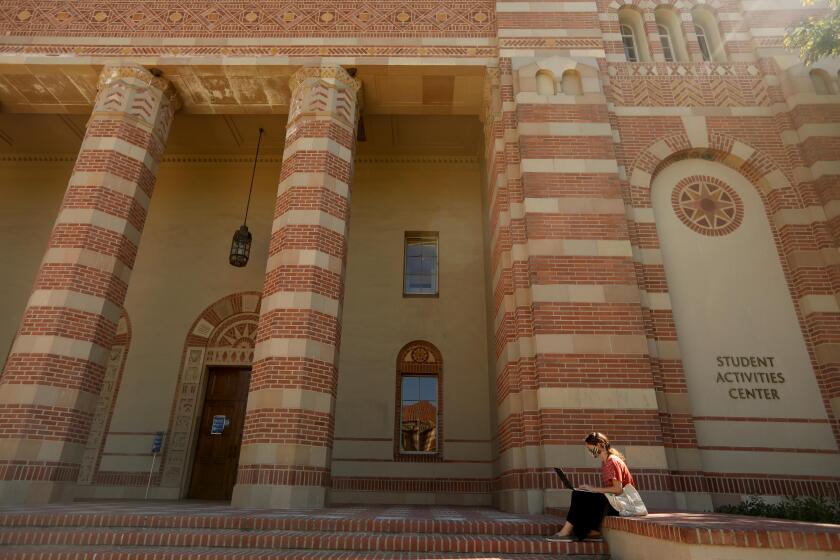L.A. Hopes to Draw Art Center
- Share via
The Art Center College of Design, one of the nation’s most prominent art schools, said it is considering the former Terminal Annex post office in downtown Los Angeles as a new home for its 1,700 full-time students and faculty.
The potential move, prompted by the school’s need to expand, could prove a major boost for downtown Los Angeles as it struggles to reinvent itself as a regional center for culture and entertainment. Staples Center, Disney Hall and the cathedral for the Archdiocese of Los Angeles are among the cultural facilities that are under construction or in development.
“This is part and parcel of the creation of a vibrant downtown Los Angeles,” said Stuart Gabriel, director for Lusk Center for Real Estate at USC. The opening of a major art school would “reinforce the depth of artistic and educational activities in the downtown area.”
The art center’s newly appointed president, Richard Koshalek, said the 18-acre Terminal Annex site on the eastern edge of downtown is one of three options under review, including remaining on its existing Pasadena campus. Koshalek, former director of the Museum of Contemporary Art, would not disclose the third potential site.
“The college is in need of expansion,” Koshalek said of the nearly 70-year-old institution, which was founded by an advertising art director. “We want to build a building that will give the school an eye on the future.”
The school anticipates the need to undertake a substantial expansion of its approximately 262,000 square feet of existing space to keep up with new technology and teaching methods.
Despite its location on 175 acres of wooded hillside, any major expansion would probably be met with neighborhood opposition over the loss of open space and increased traffic congestion, say school and city officials.
Pasadena officials have met with Koshalek to study various alternatives, said Ann Erdman, a spokeswoman for the city.
“The land is there for them to expand,” Erdman said. “The question is do they want to do that or move to a more urban” setting.
Los Angeles Promoting Terminal Annex Site
The city of Los Angeles, meanwhile, has been aggressively promoting the historic Terminal Annex site to the art center. Sprawling across 500,000 square feet of space, the Mission Revival-style complex was built in 1936 and served as the city’s main postal facility until 1989. The U.S. Postal Service hired Los Angeles real estate developer Wayne Ratkovich to find new uses for the historic but now vacant building.
Ratkovich said the art center is one of three potential tenants evaluating the property, which is a short walk from Olvera Street and Chinatown.
“We will be reaching a decision in the very near future,” Ratkovich said.
Koshalek described the search for new space as still in the preliminary stages. The art center, which opened in downtown Los Angeles before moving to Hancock Park and then Pasadena in the 1970s, will probably select a site early next year.
It will take a few years before the new campus is ready to open.
But the prospect of a lengthy selection and building process has not diminished interest among Los Angeles officials, who are courting the school as part of a strategy to broaden downtown’s appeal. Los Angeles has watched as numerous other cities, from Phoenix to New York, have used culture and entertainment to revive once-derelict downtowns.
“We believe that Art Center’s interest in the Terminal Annex building will only further establish Los Angeles as a cultural capital,” said Rocky Delgadillo, head of Mayor Richard Riordan’s Business Team.
It helps that Koshalek is familiar with downtown Los Angeles, where he worked for nearly 20 years as head of the Museum of Contemporary Art. “He has been a champion of what we have been trying to do downtown,” Delgadillo said.
The art center would join numerous new or newly expanded cultural and educational institutions downtown.
Last year, the Colburn School of Performing Arts moved its campus and 1,200 students to a new facility on Bunker Hill. While students and parents complain about the lack of restaurants open on weekends, enrollment is up 20% so far this year.
In addition, downtown office workers have been attracted to school recitals and concerts, according to Colburn President Toby Mayman.
“It has worked out beautifully,” said Mayman, whose school was previously located in a smaller facility near USC. “We get a lot of people who drop in and want to know what we are about.”
Civic officials are focusing on culture and entertainment in response to downtown’s diminished role as the region’s premier business and corporate center.
Southern California’s economic resurgence has sent vacancy rates plunging in Century City, Burbank and Irvine. But downtown Los Angeles remains saddled with millions of square feet of empty office space, a legacy of the overbuilding in the 1980s and corporate mergers that have reduced the roster of major business tenants.
Longtime downtown denizen Atlantic Richfield Co., for example, recently agreed to merge with BP-Amoco, raising questions about what Arco will do with its 200,000 square feet of downtown office space.
The new batch of cultural and entertainment amenities will play a vital role in making downtown more attractive to businesses and building a larger residential community, according to urban planners.
“There is [now] a tremendous amount of vacancies. There is a tremendous deficit in pedestrian life,” said architect Stefanos Polyzoides, whose firm crafted a downtown plan that promoted housing and a variety of activities. “Any significant mix of uses within the greater downtown is an extraordinarily good idea.”
But previous efforts to build up downtown cultural attractions have met with limited results. The Los Angeles Music Center on Bunker Hill and the Los Angeles Theatre Center on Spring Street, for example, failed to spark additional development.
Group Tries to Foster Business, Cooperation
This time around, however, the larger number of cultural attractions and the growing number of downtown residents should have a more powerful impact on downtown’s ambience, according to Carol Schatz, president of the Central City Assn. Instead of simply promoting business, the association has organized meetings of downtown cultural institutions to foster cooperation. The group has also begun advertising the entertainment and cultural aspects of the area.
“It’s in recognition that . . . we are not going to see the traditional Fortune 500 firm coming” downtown, Schatz said. “It’s part of the evolution of all downtowns, and we are not unusual in that way.”
More to Read
Sign up for Essential California
The most important California stories and recommendations in your inbox every morning.
You may occasionally receive promotional content from the Los Angeles Times.










